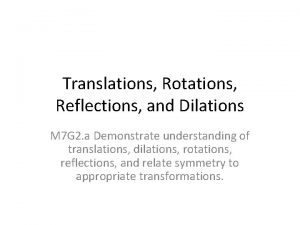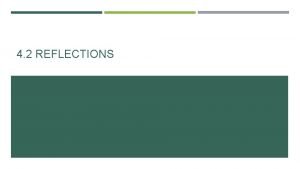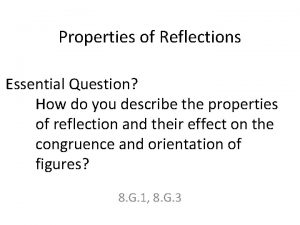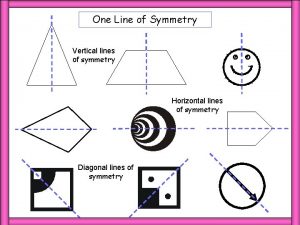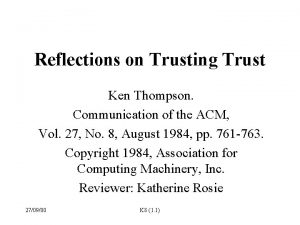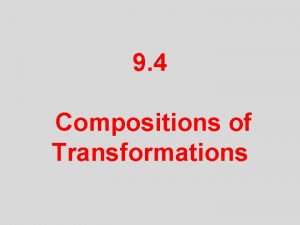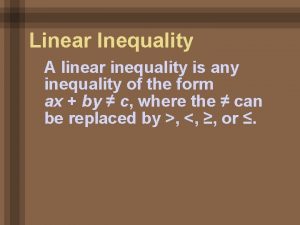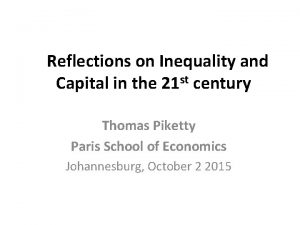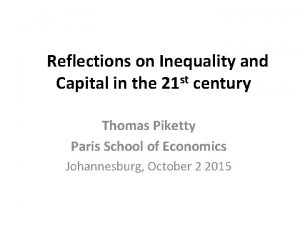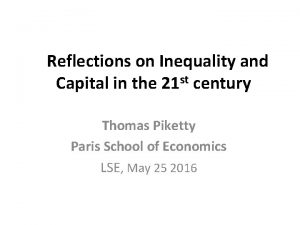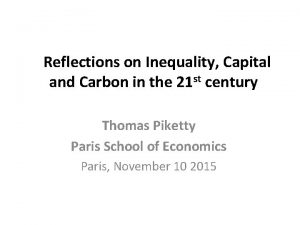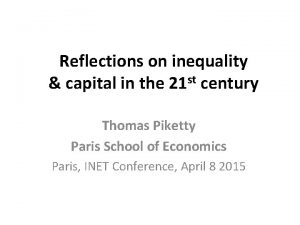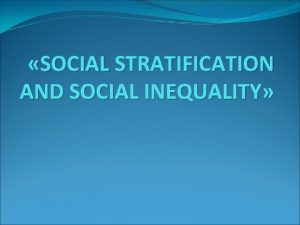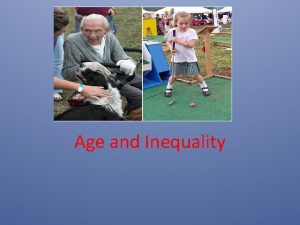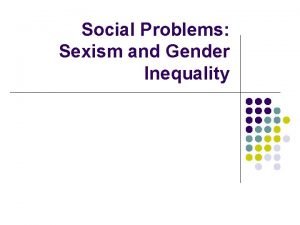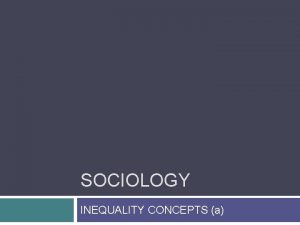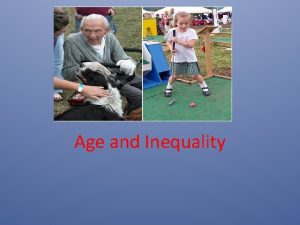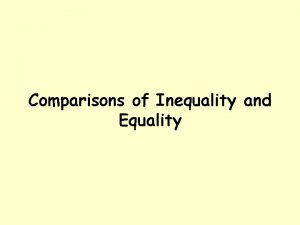Reflections on Inequality and st Capital in the













































- Slides: 45

Reflections on Inequality and st Capital in the 21 century Thomas Piketty Paris School of Economics Johannesburg, October 1 2015

• This presentation is partly based upon Capital in the 21 st century (HUP, 2014) • In this book, I study the global dynamics of income and wealth distribution since 18 c in 20+ countries. I use historical data collected over the past 15 years with Atkinson, Saez, Postel. Vinay, Rosenthal, Alvaredo, Zucman, and 30+ others. Aim is to put distribution back at the center of political economy. I attempt to develop a multidimensional approach to capital ownership and property relations, and to study beliefs systems about inequality • Today I will present a number of selected historical evolutions & attempt to draw lessons for South Africa • All series available at http: //piketty. pse. ens. fr/capital 21 c & the World Top Incomes Database: collective, on-going project


This presentation: three points • 1. The long-run dynamics of income inequality. The end of the Kuznets curve, the end of universal laws. Institutions and policies matter: education, labor, tax, etc. • 2. The return of a patrimonial (or wealth-based) society. Wealth-income ratios seem to be returning to very high levels in rich countries. The metamorphosis of capital. The key role of the legal and political system. • 3. The future of wealth concentration. With high r - g during 21 c (r = net-of-tax rate of return, g = growth rate), then wealth inequality might reach or surpass 19 c oligarchic levels. Need for more transparency about wealth. Need for progressive taxation of net wealth.

Inequality in South Africa • Income inequality = extremely high by international and historical standards. Legacy of Apartheid. Top 10% income share ≈ 60 -65% of total income (vs 30 -35% in Europe, 45 -50% in US, 55 -60% in Brasil). • Wealth inequality = probably very high as well, but we know very little. No access to estate tax data. No annual wealth tax. • Like other countries, & probably even more than others, South Africa needs more transparency about income and wealth dynamics. Progressive wealth tax = powerful way to produce information & to limit concentration of property. • BEE polices based upon voluntary market transactions are probably not enough. Progressive wealth tax = equivalent of permanent land reform. Wealth redistribution played a key role in successful development experience in Asia & Europe.

20% 18% 16% 3/27/1905 12: 00 AM 3/30/1905 12: 00 AM 4/2/1905 12: 00 AM 4/5/1905 12: 00 AM 4/8/1905 12: 00 AM 4/11/1905 12: 00 AM 4/14/1905 12: 00 AM 4/17/1905 12: 00 AM 4/20/1905 12: 00 AM 4/23/1905 12: 00 AM 4/26/1905 12: 00 AM 4/29/1905 12: 00 AM 5/2/1905 12: 00 AM 5/5/1905 12: 00 AM 5/8/1905 12: 00 AM 5/11/1905 12: 00 AM 5/14/1905 12: 00 AM 5/17/1905 12: 00 AM 5/20/1905 12: 00 AM 5/23/1905 12: 00 AM 5/26/1905 12: 00 AM 5/29/1905 12: 00 AM 6/1/1905 12: 00 AM 6/4/1905 12: 00 AM 6/7/1905 12: 00 AM 6/10/1905 12: 00 AM 6/13/1905 12: 00 AM 6/16/1905 12: 00 AM 6/19/1905 12: 00 AM 6/22/1905 12: 00 AM 6/25/1905 12: 00 AM 6/28/1905 12: 00 AM 7/1/1905 12: 00 AM 7/4/1905 12: 00 AM Share of top 1% in total pretax income Top 1% income share South Africa vs France 24% 22% South Africa France 14% 12% 10% 8% 6%

22% 20% 18% 14% 3/27/1905 12: 00 AM 3/30/1905 12: 00 AM 4/2/1905 12: 00 AM 4/5/1905 12: 00 AM 4/8/1905 12: 00 AM 4/11/1905 12: 00 AM 4/14/1905 12: 00 AM 4/17/1905 12: 00 AM 4/20/1905 12: 00 AM 4/23/1905 12: 00 AM 4/26/1905 12: 00 AM 4/29/1905 12: 00 AM 5/2/1905 12: 00 AM 5/5/1905 12: 00 AM 5/8/1905 12: 00 AM 5/11/1905 12: 00 AM 5/14/1905 12: 00 AM 5/17/1905 12: 00 AM 5/20/1905 12: 00 AM 5/23/1905 12: 00 AM 5/26/1905 12: 00 AM 5/29/1905 12: 00 AM 6/1/1905 12: 00 AM 6/4/1905 12: 00 AM 6/7/1905 12: 00 AM 6/10/1905 12: 00 AM 6/13/1905 12: 00 AM 6/16/1905 12: 00 AM 6/19/1905 12: 00 AM 6/22/1905 12: 00 AM 6/25/1905 12: 00 AM 6/28/1905 12: 00 AM 7/1/1905 12: 00 AM 7/4/1905 12: 00 AM Share of top 1% in total pretax income Top 1% income share South Africa, United States, France 24% South Africa United States 16% France 12% 10% 8% 6%

65% 60% 55% 50% 45% 3/27/1905 12: 00 AM 3/30/1905 12: 00 AM 4/2/1905 12: 00 AM 4/5/1905 12: 00 AM 4/8/1905 12: 00 AM 4/11/1905 12: 00 AM 4/14/1905 12: 00 AM 4/17/1905 12: 00 AM 4/20/1905 12: 00 AM 4/23/1905 12: 00 AM 4/26/1905 12: 00 AM 4/29/1905 12: 00 AM 5/2/1905 12: 00 AM 5/5/1905 12: 00 AM 5/8/1905 12: 00 AM 5/11/1905 12: 00 AM 5/14/1905 12: 00 AM 5/17/1905 12: 00 AM 5/20/1905 12: 00 AM 5/23/1905 12: 00 AM 5/26/1905 12: 00 AM 5/29/1905 12: 00 AM 6/1/1905 12: 00 AM 6/4/1905 12: 00 AM 6/7/1905 12: 00 AM 6/10/1905 12: 00 AM 6/13/1905 12: 00 AM 6/16/1905 12: 00 AM 6/19/1905 12: 00 AM 6/22/1905 12: 00 AM 6/25/1905 12: 00 AM 6/28/1905 12: 00 AM 7/1/1905 12: 00 AM 7/4/1905 12: 00 AM Share of top 10% in tiotal pretax income Top 10% income share South Africa, United States, France 70% South Africa United States France 40% 35% 30% 25%

65% 60% 45% 40% 3/27/1905 12: 00 AM 3/30/1905 12: 00 AM 4/2/1905 12: 00 AM 4/5/1905 12: 00 AM 4/8/1905 12: 00 AM 4/11/1905 12: 00 AM 4/14/1905 12: 00 AM 4/17/1905 12: 00 AM 4/20/1905 12: 00 AM 4/23/1905 12: 00 AM 4/26/1905 12: 00 AM 4/29/1905 12: 00 AM 5/2/1905 12: 00 AM 5/5/1905 12: 00 AM 5/8/1905 12: 00 AM 5/11/1905 12: 00 AM 5/14/1905 12: 00 AM 5/17/1905 12: 00 AM 5/20/1905 12: 00 AM 5/23/1905 12: 00 AM 5/26/1905 12: 00 AM 5/29/1905 12: 00 AM 6/1/1905 12: 00 AM 6/4/1905 12: 00 AM 6/7/1905 12: 00 AM 6/10/1905 12: 00 AM 6/13/1905 12: 00 AM 6/16/1905 12: 00 AM 6/19/1905 12: 00 AM 6/22/1905 12: 00 AM 6/25/1905 12: 00 AM 6/28/1905 12: 00 AM 7/1/1905 12: 00 AM 7/4/1905 12: 00 AM Share of top 10% in tiotal pretax income Top 10% income share South Africa, Brasil, United States, France 70% South Africa 55% Brasil 50% United States France 35% 30% 25%

This presentation: three points • 1. The long-run dynamics of income inequality. The end of the Kuznets curve, the end of universal laws. Institutions and policies matter: education, labor, tax, etc. • 2. The return of a patrimonial (or wealth-based) society. Wealth-income ratios seem to be returning to very high levels in rich countries. The metamorphosis of capital. The key role of the legal and political system. • 3. The future of wealth concentration. With high r - g during 21 c (r = net-of-tax rate of return, g = growth rate), then wealth inequality might reach or surpass 19 c oligarchic levels. Need for more transparency about wealth. Need for progressive taxation of net wealth.

• 1. The long-run dynamics of income inequality. The end of the Kuznets curve, the end of universal laws. Institutions and policies matter: education, labor, tax, etc.

• Three facts about inequality in the long-run: income inequality, wealth-income ratios (Piketty-Saez, « Inequality in the long run » , Science 2014) • Fact n° 1: in 1900 -1910, income inequality was higher in Europe than in the United States; in 2000 -2010, it is a lot higher in the United States




Top 10% Income Share: Europe, U. S. and Japan, 1900 -2010 50% U. S. Share of top decile in total income 45% Europe Japan 40% 35% 30% 25% 1900 1910 1920 1930 1940 1950 1960 1970 1980 1990 2000 2010 The top decile income share was higher in Europe than in the U. S. in 1900 -1910; it is a lot higher in the U. S. in 2000 -2010. Sources and series: see piketty. pse. ens. fr/capital 21 c.

• The rise in US inequality in recent decades is mostly due to rising inequality of labor income • It is due to a mixture of reasons: changing supply and demand for skills; race between education and technology; globalization; more unequal to access to skills in the US (rising tuitions, insufficient public investment); unprecedented rise of top managerial compensation in the US (changing incentives, cuts in top income tax rates); falling minimum wage in the US institutions and policies matter



• 2. The return of a patrimonial (or wealth-based) society. Wealth-income ratios seem to be returning to very high levels in rich countries. Intuition: in a slow-growth society, wealth accumulated in the past can naturally become very important. In the very long run, this can be relevant for the entire world. Not bad in itself, but new challenges. The metamorphosis of capital call for new regulations of property relations. The key role of the legal and political system. Democratizing capital: worker codetermination, patent laws, etc.

• Fact n° 2: wealth inequality is always a lot higher than income inequality; it is now higher in the US than in Europe • Fact n° 3: wealth inequality is less extreme today than a century ago in Europe, although the total capitalization of private wealth relative to national income has now recovered from the 1914 -1945 shocks




The metamorphosis of capital • There’s nothing bad with high wealth-income ratios (postwar reconstruction, growth slowdown), but this creates new policy challenges: financial regulation, real estate bubbles, return of inheritance A multidimensional approach to the history of capital and property relations: from land to business assets, foreign assets, real estate, public debt, immaterial capital, etc.




Figure S 5. 2. Private capital in rich countries: from the Japanese to the Spanish bubble 800% U. S. A Japan Germany France U. K. Italy Canada Australia Spain Value of private capital (% of national income) 700% 600% 500% 400% 300% 200% 1970 1975 1980 1985 1990 1995 2000 2005 Private capital almost reached 8 years of national income in Spain at the end of the 2000 s (ie. one more year than Japan in 1990). Sources and series: see piketty. pse. ens. fr/capital 21 c. 2010


Capital & inequality in America • Inequality in America = a different structure as in Europe: more egalitarian in some ways, more inegalitarian in others • The New World in the 19 th century: the land of opportunity (capital accumulated in the past matters less than in Europe; perpetual pop. growth as a way to reduce the level of inherited wealth and wealth concentration)… and also the land of slavery: extreme form of property relation • Northern US were in many ways more egalitarian than Old Europe; but Southern US were more inegalitarian • We still have the same ambiguous relationship of America with inequality today: in some ways more merit-based; in other ways more violent ( « meritocratic extremism » )





Capital & inequality in Germany • Lower market values of capital assets in Germany: lower real estate prices, and lower stock market capitalization of corporations • Stakeholder capitalism: shareholders have to share power with worker representatives, regional govt, etc. , so that the market value is much less than book value of corporation • Apparently this does not prevent German companies from producing good cars • This clearly illustrates that market and social values of capital can differ; property relations are socially, legally and historically determined


• 3. The future of wealth concentration. With high r - g during 21 c (r = net-of-tax rate of return, g = growth rate), then wealth inequality might reach or surpass 19 c oligarchic levels. Need for more transparency about wealth. Need for progressive taxation of net wealth.





Top Income Tax Rates 1900 -2013 100% 90% 80% 70% 60% 50% 40% U. S. U. K. 30% France 20% Germany 10% Japan 2010 2000 1990 1980 1970 1960 1950 1940 1930 1920 1910 1900 0% South Africa


Conclusions • The history of income and wealth inequality is deeply political, social and cultural; it involves beliefs systems, national identities and sharp reversals • In a way, both Marx and Kuznets were wrong: there are powerful forces pushing in the direction of rising or reducing inequality; which one dominates depends on the institutions and policies that different societies choose to adopt • High r-g can push toward high wealth concentration, but many other forces are also important • The ideal solution involves a broad combination of inclusive institutions, including progressive taxation, education, social & labor laws, financial transparency, economic democracy • Other solutions involve authoritarian political controls (China, Russia), but this may not be sustainable
 Write a compound inequality as an absolute value inequality
Write a compound inequality as an absolute value inequality Introduction of working capital
Introduction of working capital Source of capital reserve
Source of capital reserve Multinational capital structure
Multinational capital structure Difference between capital reserve and reserve capital
Difference between capital reserve and reserve capital Constant and variable capital
Constant and variable capital Multinational cost of capital and capital structure
Multinational cost of capital and capital structure Translation reflection rotation
Translation reflection rotation 7.g rotation vs translation
7.g rotation vs translation Reflections and translations
Reflections and translations Translations reflections and rotations
Translations reflections and rotations Verifying congruence using translations
Verifying congruence using translations Horizontal and vertical reflections
Horizontal and vertical reflections Rotation reflection translation dilation
Rotation reflection translation dilation Vertical and horizontal reflections
Vertical and horizontal reflections Symmetry
Symmetry Trig identities from reflections and rotations
Trig identities from reflections and rotations Rotations dilations reflections translations
Rotations dilations reflections translations Regulatory capital vs economic capital
Regulatory capital vs economic capital Regulatory capital vs economic capital
Regulatory capital vs economic capital Capital allocation line vs capital market line
Capital allocation line vs capital market line Voice localization using nearby wall reflections
Voice localization using nearby wall reflections Give me example
Give me example Lesson 2-2 reflections answer key
Lesson 2-2 reflections answer key Kinseyprivate
Kinseyprivate Ken thompson reflections on trusting trust
Ken thompson reflections on trusting trust Reflections on trusting trust – thompson
Reflections on trusting trust – thompson Reflections on trusting trust summary
Reflections on trusting trust summary Cs lewis reflections on the psalms
Cs lewis reflections on the psalms Reflection gcse art
Reflection gcse art Teamwork reflections for work meetings
Teamwork reflections for work meetings A streetcar named desire scene 9
A streetcar named desire scene 9 Practice 9-6 compositions of reflections answers
Practice 9-6 compositions of reflections answers 9-4 compositions of transformations
9-4 compositions of transformations 9-1 reflections
9-1 reflections Translate
Translate Lesson 2 reflections
Lesson 2 reflections Reflections copenhagen
Reflections copenhagen Reflections in the coordinate plane
Reflections in the coordinate plane Practice 12-1 reflections answer key
Practice 12-1 reflections answer key Mirror of guarding reflections
Mirror of guarding reflections Tay kwang leong
Tay kwang leong Reflections
Reflections Silver jubilee reflections
Silver jubilee reflections Definisi firewall
Definisi firewall Outline for portfolio
Outline for portfolio








